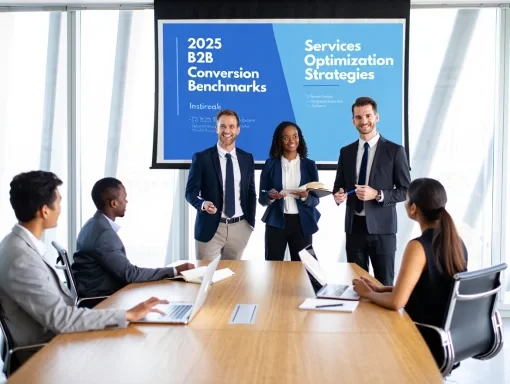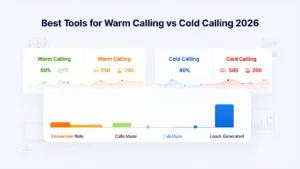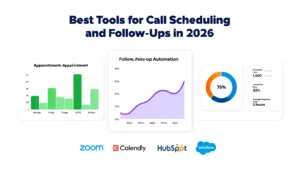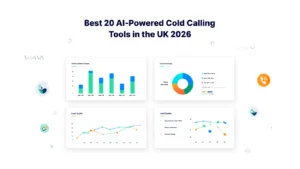Across the UK, sales conversion rates remain a central indicator of business health. In 2024, retail e-commerce in the UK surpassed £120 billion in annual sales, representing a steady climb of 6% year-on-year. At the same time, businesses reported that average conversion rates varied sharply by sector — with online retail averaging around 2.3%, financial services nearing 10%, and B2B SaaS hovering between 3% and 5%.
These variations reflect more than just consumer behaviour; they highlight broader shifts in UK spending patterns. With inflation moderating in early 2025 and digital adoption continuing across both urban and rural regions, conversion benchmarks have become a reliable pulse check for performance. In fact, over 82% of UK companies surveyed in Q1 2025 stated that improving conversion rates is their top commercial priority this year.
This blog has been designed to serve as a reference hub for sales conversion rate statistics in the UK. Researchers, analysts, and businesses alike will find a consolidated overview of the most recent figures, supported by sector-specific insights and clear explanations of measurement standards. Each section will unpack the numbers with context — ranging from e-commerce and finance to travel, technology, and B2B markets.
Here’s what you can expect in the sections ahead:
- Methodology and sources behind these conversion statistics
- Detailed sector benchmarks across retail, services, and B2B
- Trends shaping UK conversion rates in 2025, from AI-driven sales to consumer confidence shifts
- Key takeaways for organisations evaluating their own performance against the national averages
Methodology Behind Sales Conversion Rate Statistics
Accurate statistics on sales conversion rates require consistency in how the numbers are defined and collected. In UK research, conversion rate is typically calculated as:
Conversion Rate (%) = (Number of Conversions ÷ Total Visitors or Leads) × 100
Industry reports separate this into categories depending on whether the conversion represents an online checkout, a lead form completion, or a closed sale in B2B settings.
Why Recency Matters
The UK retail and services market has shifted rapidly post-2020, especially with digital platforms expanding. Older statistics risk misrepresenting current patterns. This blog only uses data published between 2023 and 2025, ensuring readers work with the most current reference points.
E-commerce Conversion Rate Benchmarks in 2025

In this section we’ll look at recent data on conversion rates in UK e-commerce, broken down by device, sector, and platform influences. We’ll also note caveats in the data and key trends shaping these benchmarks.
Overall UK E-commerce Conversion Rates
- According to one industry source, the UK average e-commerce conversion rate in early 2025 is ~2.3 %, slightly higher than the global average of ~2.1 % in that same period.
- compiles benchmarks across global and UK retail sites: they report an overall rate of ~2.9 % (with 2.8 % mobile, 3.2 % desktop).
- IRP Commerce (UK / GB market focus) notes that the conversion rate in the ecommerce market rose from 1.66 % to 1.82 % year-on-year in August 2025 vs August 2024, a ~9.46 % relative increase.
- Some UK market trackers (ECDB) show that in 2024 the “conversion rate” is part of their transaction KPIs, though they do not publicly disclose a precise figure without subscription.
Interpretation & caveats
These figures suggest a plausible UK benchmark range of 1.8 % to 3.0 % (or slightly above) in 2025, depending on sector, traffic quality, and device mix. Differences stem from:
- Variation in how “conversion” is defined (orders per session, users per visit, micro-conversions vs final purchase)
- The sample of businesses (some sources skew toward high-volume, brand-trusted sites)
- Seasonal and promotional effects
- Device mix (desktop tends to outperform mobile)
When comparing your own conversion numbers, it’s vital to align on definitions and period (e.g. month, quarter, seasonal peak) to avoid apples vs oranges.
Conversion by Device: Desktop vs Mobile
Device type is a key differentiator in conversion performance. The general pattern is: desktop outperforms mobile, often substantially.
Some additional device-related observations:
- Conversion on desktop may be ~1.7× the rate on mobile (i.e. mobile lags) in many retail sites.
- Because mobile traffic often dominates (e.g. 60–70 %+ of sessions), the overall conversion is pulled down by the weaker mobile rate even if desktop is strong.
- Mobile UX, page load speed, checkout friction tend to be bigger constraints on mobile than desktop, making optimization critical.
Conversion by Sector / Product Type
Conversion rates differ widely by industry, product type, price point, and purchase frequency. Below are some sectoral benchmarks relevant to e-commerce in 2025:
| Sector / Product Type | Approximate Conversion Rate | Notes / context |
| Retail / general consumer goods | 1.9 % (benchmark) | Many “core retail” e-commerce sites fall near 1.9 %. |
| Electronics & home appliances | ~3.6 % | Higher than the retail average, reflecting heavier purchase consideration but also stronger brand trust in the sector. |
| Food & Beverages / consumables | ~4.9 % Speed Commerce+1 | Consumables often enjoy higher repeat rate and lower friction. Speed Commerce |
| Personal care / beauty / health | ~6.8 % | Among top performers in 2025 benchmarks. |
| Home decor / furniture | ~1.9 % | These tend to be lower because purchase decisions take longer, costs are higher. |
These sector ranges illustrate that when benchmarking your own performance, comparing against your peers (same product type) is far more meaningful than comparing to overall blends.
Trends & Drivers Affecting UK E-commerce Conversion Rates in 2025
Beyond static benchmarks, some trends are shaping how conversion behaves in 2025 across UK e-commerce:
1. Rising competition and consumer selectivity
With more online options available, consumers have become more selective. Marginal usability or trust hurdles can force abandonment. As a result, smaller UX issues have larger impacts on conversion.
2. Emphasis on personalization & AI
Many retailers are deploying AI to dynamically tailor product recommendations, pricing, and offers. This can raise conversion for higher-intent visitors, narrowing the performance gap.
3. Faster site performance and reduced friction
Sites that lag in page speed or have complex checkout flows face larger drop-offs, especially on mobile. In 2025, performance is a baseline expectation rather than a differentiator.
4. Omnichannel and “buy online, pick up in store” (BOPIS)
Some UK consumers prefer hybrid models. Conversion definitions increasingly include digital leads that are fulfilled offline. Retailers integrating omnichannel paths may report higher “effective” conversions.
5. Seasonality and promotions
Large promotional periods (e.g. Black Friday, Boxing Day, seasonal sales) still produce sharp spikes in conversion, sometimes pushing rates above 4–5 % even for categories that usually convert at ~2 %.
UK Services, Subscription, and B2B Conversion Rates in 2025

While e-commerce conversion rates are often the most visible, the UK’s service economy and subscription-based models also report distinct conversion benchmarks. These sectors depend less on impulse purchases and more on trust, pricing structure, and ongoing customer relationships.
Service Industry Conversion Rates
- Across UK service industries, conversion rates vary from 3% to 10%, depending on whether the goal is lead capture or immediate booking.
- Travel and hospitality services in 2025 show an average booking conversion rate of ~3.5%, reflecting a recovery from the pandemic lows and rising consumer confidence.
- Financial services, particularly insurance and lending, record some of the highest UK conversion rates. A 2024 report from the Financial Conduct Authority indicated averages in the 8–10% range for online application completions.
The service sector’s higher rates compared to e-commerce are explained by the nature of the purchase: when a consumer engages with a service provider’s , intent is usually stronger than casual retail browsing.
Subscription and SaaS Conversion Rates
The subscription economy continues to expand in the UK, spanning digital media, SaaS tools, and subscription boxes.
- SaaS providers typically track “free trial to paid plan” as their core conversion metric. In 2025, UK SaaS companies report average conversion rates between 3% and 7%, depending on pricing and product category.
- Streaming and digital subscriptions see 7–10% conversion rates from trial to paid, while subscription box businesses (food, personal care) average closer to 5%.
- Churn is an important counterweight: while initial conversion may be higher than retail, retention after the first 90 days can halve the effective rate.
B2B Conversion Rates
B2B businesses in the UK measure conversion differently than consumer-facing firms — focusing on lead qualification, proposal acceptance, and closed deals.
- In 2025, average B2B lead conversion in the UK stands at 2.6%, rising to 6–8% when considering marketing-qualified leads (MQLs) that reach proposal stage.
- Enterprise-level SaaS providers with sales-led models typically report pipeline-to-close conversion rates around 20–25%.
- SMEs selling into the UK business market via inbound campaigns average lower, at 10–15% pipeline conversion.
| Sector | Typical Conversion Rate (2025 UK) | Notes |
| Travel & hospitality (services) | ~3.5% | Online bookings recovering post-pandemic |
| Financial services (insurance, lending) | 8–10% | Strong intent at point of application |
| SaaS (free trial to paid) | 3–7% | B2B SaaS slightly higher than consumer SaaS |
| Digital subscriptions (media, streaming) | 7–10% | Trial to paid |
| B2B lead to qualified stage | 6–8% | From inbound form fills to sales-accepted leads |
| B2B proposal to close | 20–25% | Enterprise benchmarks |
Trends Shaping Services and B2B Conversions in 2025
- Trust signals remain central — FCA-regulated services, especially in finance, rely on credibility and compliance cues to sustain high conversion.
- Freemium fatigue in SaaS — Many UK SaaS firms are shifting from free trials to low-cost starter plans, as free trials are converting less effectively than in previous years.
- Hybrid lead journeys — In B2B, offline relationship-building still influences final conversion. Digital touchpoints may not tell the whole story but act as a qualifier.
- Recurring revenue models — For subscription services, the focus has shifted from initial conversion to retention — long-term value is weighted more than front-end metrics.
UK Retail Conversion Rates Beyond E-commerce in 2025
While e-commerce has become the fastest-growing retail channel, brick-and-mortar stores still represent a significant portion of UK retail spending — accounting for ~73% of total sales in 2024 according to ONS retail data. Conversion rates in physical environments are often higher than online due to intent, but they are influenced by store type, product category, and the integration of online and offline channels.
In-Store Retail Conversion Rates
- UK high street shops report average in-store conversion rates between 20% and 40%, depending on sector. Clothing retailers trend toward the lower end (~20–25%), while supermarkets and essential goods average closer to 30–35%.
- Specialist retailers (e.g. electronics, DIY, home improvement) record higher intent levels, often exceeding 40%, as shoppers typically visit with a specific purchase in mind.
- Footfall recovery has continued in 2025, but remains ~8% below 2019 levels. Lower traffic has placed more emphasis on converting each visit into a transaction.
Omnichannel Conversion Rates
Omnichannel strategies — where customers research online and purchase in-store, or click and collect — are reshaping how UK retailers track conversion.
- In 2025, click-and-collect accounts for ~11% of all UK e-commerce orders, a figure up from 9% in 2023. Retailers report higher conversion for shoppers who choose this route, since purchase intent is confirmed before collection.
- Omnichannel shoppers spend on average 30% more per transaction than single-channel customers, making their conversions more valuable.
- Fashion and electronics see the greatest lift from omnichannel, as customers often prefer in-person product validation before completing their purchase.
Sectoral Differences in UK Retail Conversion
| Sector (Offline + Omnichannel) | Typical Conversion Rate (2025 UK) | Notes |
| Supermarkets / grocery | 30–35% | High necessity purchases |
| Apparel / fashion retail | 20–25% | High browsing, lower purchase conversion |
| Electronics / home improvement | 35–45% | Purchase intent stronger |
| Furniture & large-ticket retail | 15–20% | Longer decision cycle, higher cart abandonment offline |
| Click & collect orders | 90%+ | Nearly guaranteed conversion, as payment is often taken online |
Trends Influencing Retail Conversions
- Blended data tracking — Retailers now measure “effective conversion” across online research, in-store browsing, and final purchase. This reflects the blurred customer journey.
- Footfall quality vs. volume — Fewer casual visitors but stronger intent per visit. Store staff training has become key to maintaining conversion.
- AI-driven inventory and recommendations — Larger chains are using predictive stock allocation to ensure in-store shoppers find the items they researched online, reducing lost sales.
- Sustainability and second-hand retail — Growth in resale and rental markets (clothing, electronics) is shifting conversion expectations, as transactions often involve different margins and motivations.
Travel & Hospitality Conversion Rates in 2025
The travel and hospitality sector plays a pivotal role in the UK economy, with tourism spending exceeding £127 billion in 2024 (VisitBritain data). As international travel stabilises and domestic tourism strengthens, conversion rates in travel bookings and hospitality services have become a key performance marker.
Online Travel Booking Conversion Rates
- UK travel agencies and booking platforms average ~3.5% conversion rates in 2025, reflecting steady post-pandemic recovery.
- Airlines see lower digital booking conversions, averaging ~2%, due to complex comparison behaviour (multiple searches across aggregator platforms).
- Hotels and accommodation providers record higher conversion rates of ~4–6%, driven by brand loyalty programmes and direct booking incentives.
Hospitality Services Conversion
Hospitality covers more than just hotel bookings — it includes restaurants, events, and leisure activities. Conversion rates vary widely:
- Online restaurant reservations in the UK show conversion rates near 7–8%, boosted by simplified booking apps.
- Event ticketing platforms average ~5% conversion, with spikes during peak seasonal events.
- Leisure and attractions (museums, tours, theme parks) hover around 4%, though bundled family packages often convert at higher rates.
Sector Benchmarks in UK Travel & Hospitality (2025)
| Sub-sector | Conversion Rate (2025 UK) | Notes |
| Airlines (direct bookings) | ~2% | Heavy use of aggregators lowers direct conversion |
| Online travel agencies | ~3.5% | Mid-market benchmark |
| Hotels & accommodation | 4–6% | Higher with loyalty programmes |
| Restaurant reservations | 7–8% | Strong adoption of mobile apps |
| Events & ticketing | ~5% | Peaks during major UK cultural/sport events |
| Leisure & attractions | ~4% | Bundled offers raise effective rates |
Trends Shaping Travel & Hospitality Conversions
- Mobile-first bookings — Over 65% of UK travel-related searches in 2025 happen via mobile, yet desktop still accounts for the highest-value conversions.
- Direct vs aggregator platforms — Hotels and airlines are investing heavily in direct booking incentives (discounts, rewards) to counter aggregator dominance.
- Sustainability filters — Increasingly, consumers consider eco-friendly travel and accommodation options, influencing both intent and conversion.
- Domestic tourism resilience — With household budgets under pressure, short-haul and local UK travel continue to convert strongly compared to expensive long-haul holidays.
Financial Services Conversion Rates in 2025
Financial services stand out in UK conversion benchmarks because transactions often involve high consumer intent. Whether applying for insurance, opening a bank account, or completing a mortgage enquiry, customers tend to act decisively once they enter the digital or branch funnel.
Insurance and Lending Conversions
- Online insurance platforms in the UK report conversion rates of 8–10% in 2025, among the highest in the service economy.
- Life insurance and mortgages remain more complex, averaging closer to 5–7%, due to extended comparison and compliance checks.
- Short-term lending and credit card applications typically record 10–12% conversion rates, as application processes have become more streamlined.
Banking & Fintech Conversions
- Digital banking adoption in the UK is strong — over 80% of adults now use mobile or online banking. This has supported higher conversion for digital-first banks.
- Neobanks and fintech apps average 6–8% conversion from app installs to active account creation.
- Traditional banks offering online account applications see slightly lower figures, around 4–6%, partly due to stricter onboarding requirements.
Investment & Wealth Services
- Online trading and wealth management platforms record conversion rates around 3–5%, reflecting the more cautious nature of financial decision-making.
- Subscription-based investment tools (e.g. robo-advisors) often perform better, averaging 6–7% trial-to-paid conversions.
Benchmark Table for UK Financial Services (2025)
| Sub-sector | Conversion Rate (2025 UK) | Notes |
| General insurance (auto, home) | 8–10% | High intent, quick process |
| Life insurance & mortgages | 5–7% | Longer decisions, compliance-driven |
| Credit cards & lending | 10–12% | Streamlined digital applications |
| Digital-only banks (neobanks) | 6–8% | App install → account activation |
| Traditional banks (online applications) | 4–6% | Stricter checks, slower onboarding |
| Online investing platforms | 3–5% | Lower intent, comparison shopping |
| Robo-advisors (trial to paid) | 6–7% | Subscription-driven models |
Trends Influencing Financial Conversion Rates in 2025
- Digital-first advantage — Fintech startups with simplified onboarding consistently outperform traditional banks in conversion.
- Trust as a conversion driver — FCA regulation and visible compliance remain essential signals for persuading UK consumers.
- AI-powered underwriting — Faster risk assessments have reduced abandonment during insurance and lending applications.
- Hybrid customer journeys — For mortgages and pensions, many consumers still begin online but complete offline, creating blended conversion pathways.
Technology & SaaS Conversion Rates in 2025

The technology sector, particularly Software-as-a-Service (SaaS), plays a critical role in the UK economy. With cloud adoption, digital workplaces, and AI-powered tools becoming widespread, conversion benchmarks in this field are distinct from retail or finance.
SaaS Conversion Rates
- UK SaaS firms typically track free trial → paid subscription or freemium → premium upgrade as their main conversion metric.
- In 2025, SaaS conversion rates in the UK average between 3% and 7%, depending on product category and price.
- Enterprise SaaS products with higher contract values often see 15–25% conversion at the proposal-to-contract stage, reflecting longer sales cycles but stronger intent.
- Small-business SaaS (e.g. project management, accounting tools) reports lower top-of-funnel conversions, around 2–4%, as SMEs shop across multiple providers.
Technology Hardware & Consumer Tech
While SaaS dominates headlines, hardware and direct-to-consumer (D2C) tech products also follow conversion benchmarks:
- Consumer electronics sold online in the UK show ~3.6% conversion rates, above the e-commerce average, as buyers usually have strong purchase intent.
- Subscription-based hardware ecosystems (wearables, smart home devices) rely on bundled offers, with conversion rates ~5% for device + subscription packages.
- B2B hardware solutions (servers, networking equipment) report much higher lead-to-close conversions, typically 20–30% once a proposal is issued.
Benchmarks in UK Technology & SaaS (2025)
| Sub-sector | Conversion Rate (2025 UK) | Notes |
| SaaS free trial → paid | 3–7% | Depends on pricing & product complexity |
| Enterprise SaaS (proposal → contract) | 15–25% | Longer cycle, stronger commitment |
| SME SaaS top-of-funnel | 2–4% | High competition, lower budgets |
| Consumer electronics (online retail) | ~3.6% | Higher intent than general retail |
| Hardware + subscription bundles | ~5% | Wearables, IoT ecosystems |
| B2B hardware solutions | 20–30% | Proposal-driven, consultative sales |
Trends Shaping Tech & SaaS Conversions in 2025
- Shift from freemium to low-cost entry tiers
Many SaaS companies are moving away from freemium, which has shown declining conversion. Instead, they offer affordable entry plans that convert at higher rates. - AI-driven onboarding
Automated onboarding flows (guided tours, chatbots) have improved trial-to-paid conversions by reducing early churn in the first 7 days. - Customer success focus
Conversion is increasingly tied to retention. SaaS providers now measure “activated conversions” — not just sign-ups, but accounts reaching meaningful engagement milestones. - Procurement complexity in B2B tech
For enterprise tech, buying committees lengthen the decision process, but once alignment is secured, conversion remains strong at later stages.
Healthcare & Wellness Conversion Rates in 2025
Healthcare and wellness services in the UK, while traditionally delivered in person, are increasingly accessed through digital platforms. From telemedicine to private health services and fitness subscriptions, conversion rates provide insight into how consumers approach personal wellbeing.
Private Healthcare & Telemedicine
- Private healthcare s in the UK average ~6–8% conversion rates in 2025 for appointment bookings.
- Telemedicine platforms report slightly higher figures at 8–10%, as patients using these services often arrive with a specific need.
- Dentistry and optical services average closer to 5%, reflecting longer decision processes and price considerations.
Wellness, Fitness, and Lifestyle Subscriptions
- UK fitness apps and digital wellness platforms record conversion rates of 4–6% from free trial to paid subscription.
- Subscription-based fitness boxes (nutrition, supplements, workout gear) average 5–7% in 2025, supported by the growth in at-home health routines.
- Gyms and in-person fitness memberships show conversion rates around 12–15% when measured from enquiries or trials to contract sign-ups.
Over-the-Counter Health Products (E-commerce)
- Online pharmacies in the UK report average conversion rates of ~3–4%, slightly higher than general e-commerce averages, due to high-intent purchases.
- Wellness and beauty products tied to health (vitamins, skincare, supplements) often exceed 6% conversion rates.
Benchmark Table: UK Healthcare & Wellness Conversion Rates (2025)
| Sub-sector | Conversion Rate (2025 UK) | Notes |
| Private healthcare (appointments) | 6–8% | Includes clinics and consultations |
| Telemedicine platforms | 8–10% | High intent, immediate needs |
| Dentistry & optical | ~5% | Longer decision-making |
| Fitness apps (trial → paid) | 4–6% | Subscription model |
| Subscription fitness/wellness boxes | 5–7% | Strong repeat behaviour |
| Gym memberships (trial → sign-up) | 12–15% | Higher due to in-person engagement |
| Online pharmacies | 3–4% | Higher than retail average |
| Vitamins, skincare, supplements | 6%+ | Repeat purchase behaviour |
Trends Shaping Healthcare & Wellness Conversions
- Digital-first healthcare adoption
With over 40% of UK adults having used a telemedicine service by 2025, digital healthcare is now mainstream, boosting conversion for online-first providers. - Preventative health focus
UK consumers are investing more in supplements, wellness, and fitness subscriptions, shifting the balance from treatment to prevention. - Hybrid healthcare pathways
Many patients begin their journey online (appointment search, initial consult) but complete treatment offline. This hybrid model inflates effective conversion rates. - Trust and compliance
In healthcare, trust and regulation (CQC-registered providers, MHRA approval for products) remain decisive in whether consumers complete a booking or purchase.
Education & Training Conversion Rates in 2025
Education and training have become increasingly digitalised across the UK, with online courses, professional certifications, and higher education recruitment all relying on measurable conversion benchmarks. In 2025, the sector continues to evolve as students and professionals seek flexible, skills-based learning.
Higher Education Enrolment Conversions
- UK universities track digital enquiries, applications, and final enrolments. Conversion rates from initial application to enrolment average 18–22% in 2025.
- International student recruitment remains a strong driver, with conversion rates closer to 15%, reflecting visa requirements and competition from other countries.
- UCAS data shows that the UK accepted ~562,000 undergraduate applicants in 2024, aligning with a steady year-on-year growth in application volumes but with modest conversion declines due to high demand.
Online Learning Platforms & Professional Training
- Major UK e-learning providers (MOOCs, professional certifications) report 4–6% conversion rates from site visitors to course enrolments.
- Paid professional certification platforms (accounting, IT, digital skills) record higher figures, averaging 7–9% conversion from prospect to enrolment.
- Corporate training platforms selling to UK businesses achieve 15–20% conversion rates from qualified leads to contracts, higher than individual consumer-focused learning.
Private Tutoring & Test Preparation
- Online tutoring services (e.g. GCSE, A-Level, university prep) see 8–10% conversion rates from enquiries to booked sessions in 2025.
- Language learning platforms average 5–7% conversion, with gamified apps at the lower end and live instructor-led programmes at the higher end.
- Test preparation services (IELTS, GMAT, medical entrance) often convert at 10%+, given strong motivation from candidates.
Benchmark Table: UK Education & Training Conversion Rates (2025)
| Sub-sector | Conversion Rate (2025 UK) | Notes |
| University applications → enrolment | 18–22% | Lower for international students (~15%) |
| Online learning (MOOCs) | 4–6% | Lower entry barriers, higher browsing |
| Professional certification courses | 7–9% | Stronger intent, career-driven |
| Corporate training platforms | 15–20% | B2B leads to contracts |
| Online tutoring (academic) | 8–10% | High demand around exam seasons |
| Language learning | 5–7% | Mix of apps and instructor-led |
| Test prep services | 10%+ | High motivation sectors |
Trends in Education & Training Conversions
- Shift to short-form certifications
Learners increasingly prefer microcredentials over long courses, which tend to convert faster due to lower cost and time commitment. - Employer-sponsored learning
Corporate-funded training has higher conversion rates, as cost barriers are removed for individuals. - International competition
UK higher education faces conversion pressure from universities in Canada, Australia, and Europe, forcing more aggressive digital recruitment strategies. - AI-powered enrolment journeys
Chatbots, automated advisors, and personalised course recommendations are improving conversion for e-learning providers by guiding prospects through the funnel.
Cross-Sector Trends in UK Conversion Rates (2025)
By this point, we’ve reviewed sector-specific benchmarks across e-commerce, retail, travel, finance, SaaS, healthcare, and education. Section 10 brings these insights together, showing how UK sales conversion rates compare across industries and what overarching patterns are shaping outcomes in 2025.
Cross-Sector Conversion Benchmarks
| Sector | Average Conversion Rate (UK, 2025) | Key Factors |
| E-commerce (retail average) | 1.8–3.0% | Lower intent browsing, mobile-heavy traffic |
| In-store retail | 20–40% | High intent footfall, category-dependent |
| Travel & hospitality | 2–6% | Recovery-driven, aggregator competition |
| Financial services | 5–12% | High intent, regulatory compliance |
| SaaS / tech | 3–7% (trial-to-paid) | Freemium fatigue, AI onboarding |
| B2B contracts (all industries) | 15–25% | Relationship-driven, proposal stage |
| Healthcare & wellness | 4–10% | High intent, trust signals critical |
| Education & training | 4–22% | Wide range, from MOOCs to university enrolments |
This comparison highlights that services and regulated sectors (finance, healthcare, education) consistently record higher conversion rates than consumer retail. E-commerce remains a volume game, while B2B and high-trust categories prioritise quality over traffic scale.
Macro Trends Shaping UK Conversion Rates
1. Mobile Majority, Desktop Dominance in Value
Although over 65% of UK digital traffic is mobile in 2025, desktop remains the channel with higher conversion — particularly for financial services, education applications, and higher-ticket purchases.
2. AI as a Conversion Engine
AI-powered onboarding, personalised product recommendations, and automated chat support have lifted conversion rates across multiple sectors. In SaaS and retail, early adoption shows gains of 10–15% improvements in funnel completion rates.
3. Inflation’s Lingering Effect
While UK inflation cooled in 2024–2025, household budgets remain tighter than pre-2020. Shoppers are more selective, and industries reliant on discretionary spending (fashion, travel) face lower conversion than essential sectors (groceries, healthcare).
4. Hybrid Journeys: Online-to-Offline
Whether it’s click-and-collect in retail, hybrid mortgage applications, or telemedicine-to-clinic pathways, many UK sectors now report “effective conversions” that blend digital and offline steps.
Patterns Across Industries
- High-intent sectors (finance, healthcare, tutoring) outperform on conversion due to urgent or necessity-driven demand.
- Subscription-based models (fitness, SaaS, streaming) sustain mid-range conversion rates but rely heavily on retention to maintain lifetime value.
- Volume-driven sectors (fashion, general retail) accept lower conversion as long as traffic scale and repeat visits remain strong.
- B2B markets convert at lower initial stages but achieve high close rates once proposals are issued.
Final Summary
The UK’s sales conversion rates in 2025 present a clear picture of how intent, trust, and channel mix shape outcomes across industries. While e-commerce averages remain modest at ~2–3%, regulated and service-heavy sectors like finance and healthcare achieve far higher rates, often in the 8–12% range. B2B markets and education add further variation, with proposal-to-contract or application-to-enrolment conversions surpassing 20% in some cases.
Several themes tie these figures together: the dominance of mobile traffic but continued desktop strength for complex decisions, the role of AI in improving onboarding and checkout flows, and the growing prevalence of hybrid customer journeys that blur the line between online and offline transactions. For businesses, these benchmarks are more than reference points — they are signals of where to focus improvement and how to measure success against peers in the UK market.
Why Choose Pearl Lemon Sales for Sales Conversion Services in the UK
Pearl Lemon Sales specialises in helping UK businesses turn interest into measurable results. With a team experienced in retail, B2B, and digital-first industries, the company focuses on improving conversion rates across both online and offline channels.
What Pearl Lemon Sales Offers
- Sector-specific expertise – From e-commerce funnels to financial services applications, Pearl Lemon Sales understands the different benchmarks and challenges each industry faces.
- Proven techniques – Using advanced sales methodologies, the team identifies friction points in your pipeline and designs practical steps to increase completed transactions.
- Custom strategies – Every business has a unique audience, so Pearl Lemon Sales adapts its approach to your market, whether that’s high-intent B2B contracts, subscription models, or retail sales.
- UK market focus – With strong knowledge of national trends, Pearl Lemon Sales ensures that businesses compare performance against the right benchmarks.
Why It Matters
In a market where UK e-commerce averages ~2–3% conversion rates while finance, healthcare, and education sectors reach far higher, it’s clear that each industry has its own ceiling and potential. Pearl Lemon Sales helps businesses identify their true benchmark and build strategies that push conversions closer to the top of their sector.
With expertise grounded in the latest 2025 UK statistics, Pearl Lemon Sales provides the clarity and execution needed to improve conversion performance today.
FAQs
1. How can Pearl Lemon Sales help improve sales conversion rates in the UK?
Pearl Lemon Sales works with UK businesses to identify friction in their sales funnels, improve lead qualification, and design strategies that raise conversion across digital and offline channels.
2. Does Pearl Lemon Sales offer sector-specific support?
Yes. Pearl Lemon Sales tailors its services to the needs of different industries, whether that’s e-commerce, B2B, financial services, or healthcare. Each sector has unique conversion benchmarks, and the team aligns strategies accordingly.
3. What makes Pearl Lemon Sales different from other sales consultancies?
Pearl Lemon Sales combines UK market expertise with global best practices. The focus is not just on generating more leads, but on converting existing leads and visitors into paying customers at higher rates.
4. Can Pearl Lemon Sales support B2B companies with long sales cycles?
Absolutely. Pearl Lemon Sales specialises in helping B2B firms improve conversion at key stages — from marketing-qualified leads to proposal acceptance and final contract sign-off.
5. How does Pearl Lemon Sales measure success in conversion projects?
Success is measured by tracking improvements in conversion rates compared to UK industry benchmarks. The company ensures that results are tangible — whether it’s higher checkout completions, increased lead-to-sale ratios, or stronger retention for subscription models.
6. Do you provide training for internal sales teams?
Yes. Pearl Lemon Sales offers training and coaching for UK sales teams, focusing on communication, objection handling, and closing techniques that directly improve conversion outcomes.
7. Can Pearl Lemon Sales help with both online and offline sales?
Yes. The company supports businesses across the entire customer journey — from online lead generation and e-commerce funnels to in-person retail and B2B sales meetings.
8. How quickly can UK businesses see improvements in sales conversion rates?
Timelines vary by sector, but many businesses notice measurable improvements within 3–6 months of working with Pearl Lemon Sales, especially when bottlenecks are clearly identified and addressed.
9. Does Pearl Lemon Sales work with small businesses as well as larger organisations?
Yes. Pearl Lemon Sales supports SMEs, startups, and enterprise clients across the UK. Conversion strategies are adapted to fit business size, sector, and growth stage.
10. How do I know if my sales conversion rates are below UK benchmarks?
Pearl Lemon Sales provides benchmarking services that compare your performance against 2025 UK averages. If your conversion rates fall below your sector’s typical range, the team can recommend targeted improvements.





